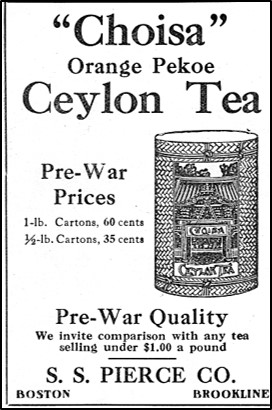
Happiness can be a warm cup of tea. But this 1921 advertisement made me realize that a hundred years ago people reminisced about even earlier good old days. The ad assured readers that “Choisa” Orange Pekoe Ceylon Tea is of “pre-war quality” and available at “pre-war prices.”
I put quotes around “Choisa” to make what I wrote match the old ad – but I’m very foggy on why the quote marks are needed.

I wonder if “Choisa” is based on a language used in Ceylon. That might account for the quotation marks.
Maybe . . . that would make sense.
Choisya is the Mexican Orange Blossom. Maybe there is a connection?
Choisa and choisya are really similar words.
This really is a mystery. Choisa seems to be a member of the rue family called, as ReginaMary said, the Mexican Orange Blossom, or mock orange, an ornamental, not drinkable. Choysa appears to be a brand name of tea now owned by Unilever, a black tea popular in New Zealand. Maybe that is why the quotation marks, a different spelling from another company’s tea blend?
Wow – you pulled a lot of things together. Thanks for taking the time to research this. It’s interesting that there still is a tea in New Zealand with a very similar name.
I love a food mystery!
Curious indeed! Choisa first appears in the newspaper advertisements in 1909.
The name “Choisa” was trademarked by the S. S. Pierce company in 1908 and begun use the same year.
Apparently, Pierce named a line of groceries the “Choisa”, including tinned coffee, sardines, jams, spreads, etc. Perhaps he just liked the sound of it–it can be a word in Portuguese, and was a surname in some places. Perhaps it was the appeal of the “exotic”.
It’s interesting that Choisa was a line of groceries – and not just tea. I never would have guessed that from just reading the ad. You might be right that the use of an “exotic” word makes the product seem special. Choisa also sounds a bit like “choice.”
It sounds like Choisa was an established brand by 1921.
Makes me want to find that tea even if it isn’t now sold at prewar prices. 😁
You can find the tins it came in!
Wow, I’m often surprised at the hundred-year-old items that turn up on Ebay, at flea markets, etc.
Good thing that you’d be willing to pay more. I don’t think that you’ll find any teas at “prewar prices.” 🙂
Lots of thoughts about ‘Choisa’. I’d assumed it was a deliberate misspelling of ‘Choicer’, commenting on the quality of the tea!
Similarly to you, the name reminded me of “choice.”
How intriguing – I would love a cup of this tea, but not one using leaves from an original tin!
Your comment makes me wonder about the shelf life of tea leaves.
I’m not a tea drinker so this has zero appeal for me. However I am intrigued by the idea that competition between companies may have lead to a “price war”… I sometimes feel that food companies and ad agencies were manipulating the public!
Some things haven’t changed. Ad writers have been trying to influence human behavior to get people to make certain purchasing decisions for a long time.
I wonder how one could ge/judcompare ‘pre-war quality’.
Judge/compare
Who knows . . . Maybe they weren’t able to import tea from Ceylon during the war.
That is a name familiar from my days in Boston in the 1960’s. I wonder what happened to S.S. Pierce.
Maybe they went out of business or got bought by some other company. Until I saw your comment, I hadn’t realized that S.S. Pierce was still around in the the 1960’s.
I couldn’t find too much information, I just remembered the name.
Love a warm cup of warm… also love a glass of cold sweet tea! It is interesting that if one drinks enough coffee or tea you can definitely tell the difference whether it’s a cheaper brand or not… guess that goes with a lot of things🧐😀
Yes, I think you’re right. It’s easier to judge the quality of foods that are very familiar.
I think Shoreacre’s nailed it.xxx